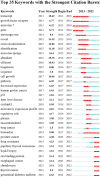Bibliometric analysis of the research hotspots and trends of circular RNAs
- PMID: 38818139
- PMCID: PMC11137546
- DOI: 10.1016/j.heliyon.2024.e31478
Bibliometric analysis of the research hotspots and trends of circular RNAs
Abstract
Background and objective: Circular RNAs (circRNAs) have garnered considerable attention in the study of various human diseases due to their ubiquitous expression and potential biological functions. This study conducts a bibliometric and visualization-based analysis of circRNA-related research in diseases, aiming to reveal the current status, hotspots and emerging trends within the field.
Methods: Literature published between 2013 and 2022 and indexed in the Web of Science core databases was retrieved. Visualizations of publication volume, countries, authors, institutions, journals, references, and keywords were performed. Microsoft Excel (2021) was used to analyze and graph publication volume and growth trends. Additionally, CiteSpace (version 6.1.R6) and VOSviewer (version 1.6.18) were employed to visualize the bibliographic information.
Results: Between 2013 and 2022, a total of 4195 relevant articles on circRNA in the context of diseases were identified. These articles covered 56 countries, 2528 institutions, 19,842 authors and 698 journals, citing 85,541 references. The annual publication volume showed an exponential growth trend, with rapid development post-2017. China, the United States and Germany emerged as the top three contributors, demonstrating high publication volume and total citations. Notably, Nanjing Medical University exhibited the highest publication volume, boasting 291 articles. Burton B. Yang and Li Yang consistently ranked among the top 10 authors in terms of publication volume and citations, emerging as core contributors in this research field. The journal Bioengineered ranked first in terms of published articles (160), with an impact factor of 6.832, while Molecular Cancer garnered the highest impact factor (41.4), solidifying its position as a top journal in this field. Furthermore, high-frequency keywords included "expression" "proliferation" "biomarker" "microRNA" "cancer", signifying the prevailing research hotspots and principal themes of this field over the past decade. As of 2022, "biomarker", "prostate cancer","drug resistance","papillary thyroid carcinoma", etc. continued as keywords during the outbreak period. At present, the value of circRNA application is mainly reflected in the two aspects of biomarkers and therapeutic targets, and the prediction of accurate diagnosis and precise treatment based on big data analysis, especially in cancer, will become a hot spot of research in the future.
Conclusion: The trajectory of circRNA research from its biological origins to its applications in diseases has been delineated from 2013 to 2022. However, the transition to disease-specific applications and exploration of biological functions warrants further attention in future research endeavors.
Keywords: Bibliometric analysis; CiteSpace; VOSviewer; Visualization; circRNA.
© 2024 The Authors. Published by Elsevier Ltd.
Conflict of interest statement
The authors declare that they have no known competing financial interests or personal relationships that could have appeared to influence the work reported in this paper.
Figures











Similar articles
-
Research Trends in the Application of Artificial Intelligence in Oncology: A Bibliometric and Network Visualization Study.Front Biosci (Landmark Ed). 2022 Aug 31;27(9):254. doi: 10.31083/j.fbl2709254. Front Biosci (Landmark Ed). 2022. PMID: 36224012
-
Global research landscape and trends of papillary thyroid cancer therapy: a bibliometric analysis.Front Endocrinol (Lausanne). 2023 Sep 19;14:1252389. doi: 10.3389/fendo.2023.1252389. eCollection 2023. Front Endocrinol (Lausanne). 2023. PMID: 37795362 Free PMC article.
-
Bibliometric Analysis of Global Circular RNA Research Trends from 2007 to 2018.Cell J. 2021 Jul;23(2):238-246. doi: 10.22074/cellj.2021.7143. Epub 2021 May 26. Cell J. 2021. PMID: 34096225 Free PMC article.
-
Emerging research themes in maternal hypothyroidism: a bibliometric exploration.Front Immunol. 2024 Mar 26;15:1370707. doi: 10.3389/fimmu.2024.1370707. eCollection 2024. Front Immunol. 2024. PMID: 38596686 Free PMC article. Review.
-
The research landscape of ferroptosis in neurodegenerative disease: a bibliometric analysis.Front Aging Neurosci. 2024 Jun 17;16:1417989. doi: 10.3389/fnagi.2024.1417989. eCollection 2024. Front Aging Neurosci. 2024. PMID: 38962561 Free PMC article. Review.
Cited by
-
Research frontiers and hotspots in optical coherence tomography applications among patients with acute coronary syndromes: Bibliometric and visual analysis.Medicine (Baltimore). 2024 Oct 25;103(43):e40216. doi: 10.1097/MD.0000000000040216. Medicine (Baltimore). 2024. PMID: 39470522 Free PMC article.
References
Publication types
LinkOut - more resources
Full Text Sources
Research Materials
Miscellaneous

